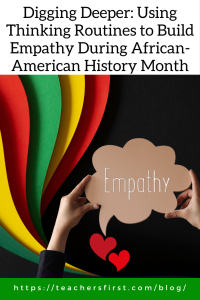As we celebrate and observe African-American History Month in February, we must recognize the importance of making this topic relevant to students beyond just learning about famous African Americans and their contributions to this country’s history. Including specific activities that promote deeper thinking allows us to deepen understanding while building empathy for others. Developing empathy skills leads to improved classroom climates that embrace the differences of all class members.
Dr. Brene Brown discusses the four steps to showing empathy in this YouTube video, pointing out that empathy fuels connections and that displaying empathy requires connecting with others. She discusses empathy as a vulnerable choice that requires connecting with one’s own emotions to be able to connect with others and emphasizes the importance of genuine connection and listening without obligation to fix or minimize someone’s pain.
One approach to incorporating empathy into your African-American History Month celebrations is to use the research-based resources provided by Project Zero’s Thinking Routines Toolbox (reviewed here). Each thinking routine supports students by making their thinking visible to themselves and the teacher while deepening their understanding of the topic.
Project Zero offers dozens of thinking routines divided into ten categories, including digging deeper into ideas, perspective-taking, and considering conflicts, dilemmas, and perspectives. Browse the thinking routines by category or search by teaching subject, thinking disposition, or competency.
Let’s look at how we can use thinking routines and the four steps discussed by Dr. Brene Brown—specifically during African-American History Month—to help build empathy.
- Perspective taking – The 3 Whys is a thinking routine that encourages students to consider the significance of a specific situation or topic with global implications in mind. This routine encourages thinking about people or events to dig deeper into why the information is significant.
- Introduce a video or biography of a lesser-known figure like Max Robinson, who broke racial barriers in media. Ask students to consider why more people don’t know about Max Robinson. Why hasn’t he received more recognition? Why is it important to learn about other African Americans who aren’t as well-known? These “why” questions focus on broader issues around representation in history narratives, marginalized groups’ struggles, and the importance of elevating overlooked stories.
- Copy and use this graphic organizer found on Canva for Education (reviewed here) when using The 3 Whys thinking routine.
- Staying out of judgment – Peel the Fruit is a routine that focuses on digging deeper into our understanding of events by exploring different layers beyond the surface facts, encouraging students to trace deeper issues such as equity, identity, and systemic change without applying judgments to actions.
- Use Peel the Fruit as you teach about the Montgomery bus boycott. Begin with lessons on the facts about the boycott, then use this thinking routine to understand the more profound significance of this event by asking questions that encourage understanding of the boycotters’ motivations, how their actions led to other events in the civil rights movement, and how their actions looked from different perspectives.
- This graphic organizer shared by Thinking Pathways provides a visual look at the different parts of this thinking routine and includes a downloadable student template.
- Recognize emotions – The Feelings and Options thinking routine asks students to analyze a dilemma in a way that supports the exploration of different perspectives and to practice communicating kindly and constructively. This routine encourages students to think beyond their experiences and perspectives and develop empathy for others in different situations.
- Ruby Bridges is famous for being the first African-American child to integrate an all-white school in the South. Use the Feelings and Options routine to encourage students to consider the perspectives of Ruby, the other students, her parents, and the adults involved in her attending this school.
- A graphic organizer in the resource links for this thinking routine is suitable for individual students, small groups, or whole class discussions.
- Communicate understanding – I Used to Think… Now I Think is a routine that encourages students to reflect upon their learning. When developing empathy, prompt students to consider how their perspectives changed during the learning process and discuss specific information that led to these changes.
- Younger students might initially think Martin Luther King was a famous speaker, but now understand he organized boycotts and civil rights marches. High school students might make connections between sharecropping and the exploitation of freed people.
- Copy this simple graphic organizer made using Google Slides (reviewed here) that students can use individually or in groups to communicate their understanding.
Using thinking routines to provide a deeper, more focused look at African-American history is an excellent way to encourage students to build empathy. Thinking routines also improve classroom climate through community-building discussions where students connect by sharing diverse perspectives. Thinking routines promote inclusion by welcoming varied interpretations and honoring all student voices. The open-ended exploratory nature of these routines reduces intimidation and encourages academic risk-taking without fear of being wrong. Finally, the guiding questions in thinking routines spark curiosity, which organically stimulates higher-order thinking and increases engagement.
Check out TeachersFirst’s resources related to empathy and Black History Resources special topics collection pages to find additional resources for use during African-American History Month.


